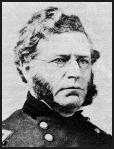Henry Hayes Lockwood
| Henry Hayes Lockwood | |
|---|---|
 Henry H. Lockwood | |
| Born |
August 17, 1814 Kent County, Delaware |
| Died |
December 7, 1899 (aged 85) Georgetown, D.C. |
| Place of burial | U.S. Naval Academy Cemetery Annapolis, Maryland |
| Allegiance |
Union |
| Service/branch |
|
| Years of service | 1836 - 1837, 1861 - 1865 |
| Rank |
|
| Commands held | Middle Department |
| Battles/wars | American Civil War |
| Other work |
Professor Commander of the U.S. Naval Observatory |
Henry Hayes Lockwood (August 17, 1814 – December 7, 1899) was an American soldier and authority on military tactics.
Early life
Lockwood was born in Kent County, Delaware. He graduated from the United States Military Academy in 1836, served in the Seminole Wars as a lieutenant in the Second Artillery, and resigned his commission in the next year. In 1841 he was made professor of mathematics at the United States Naval Academy, where from 1851 to 1866 he held the professorship of field artillery and infantry tactics. In 1856, his son, James Booth Lockwood, was born. James would later go on to participate in and perish on the Lady Franklin Bay Expedition in 1884.
Civil War
Lockwood entered the Union Army as colonel of the 1st Delaware Infantry, was commissioned a brigadier general of volunteers on August 8, 1861, and served in the defenses of the lower Potomac River. He commanded a brigade attached to XII Corps at the Battle of Gettysburg. His brigade was kept directly under corps headquarters during the battle, because the acting corps commander, Brig. Gen. Alpheus S. Williams, did not want an unknown officer commanding 1st Division just because he was senior of Brig. Gen. Thomas H. Ruger. The brigade was absorbed into the division after Williams returned to that command and Maj. Gen. Henry W. Slocum resumed corps command. In the winter of 1863–64 Lockwood was commander of the Middle Department, with headquarters at Baltimore, Maryland. Later he took part in the Richmond Campaign, briefly commanding a division in V Corps. He was sent back to the Middle Department because his corps commander, Maj. Gen. Gouverneur K. Warren, did not find him sufficiently competent for so high a rank.[1] On July 23, 1862, Lockwood commandeered the Cessford property at Eastville, Virginia for his headquarters and remained in residence of the property throughout the war.[2]
Postbellum career
After the war, Lockwood became a professor at the U.S. Naval Academy. He commanded the U.S. Naval Observatory from 1870 to 1876 and retired from service on August 18, 1876. He died in Georgetown, D.C., and is buried at the U.S. Naval Academy Cemetery in Annapolis, Maryland.[3]
He was the author of Manual of Naval Batteries (1852) and Exercises in Small Arms and Field Artillery (1852).
See also
- List of American Civil War generals
Notes
- ↑ http://www.civilwar.com/?option=com_officialrecord&series=Series%20I&volume=Volume%20XXXVI&part=Part%20III&page=442
- ↑ Jean M. Mihalyka and Mary C. Taylor (June 2003). "National Register of Historic Places Inventory/Nomination: Cessford". Virginia Department of Historic Resources.
- ↑ Eicher, p. 351.
References
 This article incorporates text from a publication now in the public domain: Gilman, D. C.; Thurston, H. T.; Moore, F., eds. (1905). "article name needed". New International Encyclopedia (1st ed.). New York: Dodd, Mead.
This article incorporates text from a publication now in the public domain: Gilman, D. C.; Thurston, H. T.; Moore, F., eds. (1905). "article name needed". New International Encyclopedia (1st ed.). New York: Dodd, Mead.
- Eicher, John H., and Eicher, David J., Civil War High Commands, Stanford University Press, 2001, ISBN 0-8047-3641-3.
External links
- "Henry Hayes Lockwood". Find a Grave. Retrieved 2009-04-23.